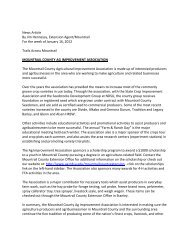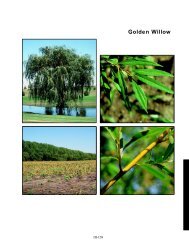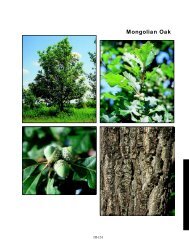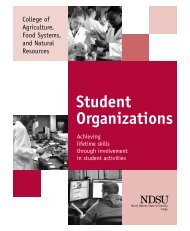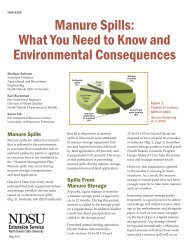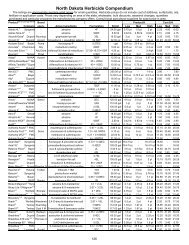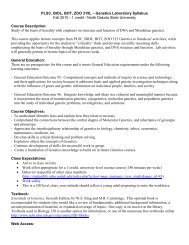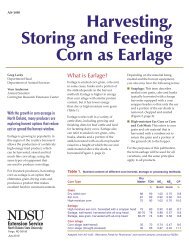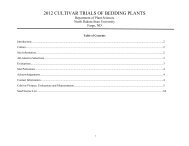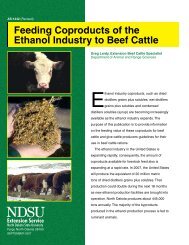NDSU Beef Feedlot - NDSU Agriculture - North Dakota State ...
NDSU Beef Feedlot - NDSU Agriculture - North Dakota State ...
NDSU Beef Feedlot - NDSU Agriculture - North Dakota State ...
Create successful ePaper yourself
Turn your PDF publications into a flip-book with our unique Google optimized e-Paper software.
Challenges and Opportunities for <strong>Beef</strong> <strong>Feedlot</strong>s in <strong>North</strong> <strong>Dakota</strong><br />
V.L. Anderson<br />
<strong>NDSU</strong> Carrington Research Extension Center<br />
Introduction<br />
<strong>North</strong> <strong>Dakota</strong> is known as a beef cow/calf state, with nearly a million cows scattered across much of the<br />
state. The feeding industry is not well developed in <strong>North</strong> <strong>Dakota</strong> so the question has often been<br />
asked, what is the potential for this segment of the beef industry? In one three-year study conducted at<br />
the Carrington Research Extension Center in the early 1990s, 130 head of <strong>North</strong> <strong>Dakota</strong> feeder cattle<br />
were gathered up each fall from cooperating producers and fed to finishing weight at the Carrington<br />
Center or at commercial feedyards in Kansas or Nebraska. Cattle in the southern yards gained faster<br />
on diets with steam-flaked corn and added fat. Cattle finished at Carrington were less efficient but the<br />
cost of gain was $.046 less per pound. This paper is a discussion of the positive and negative aspects<br />
of the resources, geography, markets, attitudes, education, research and other factors that may affect<br />
the development and success of beef feedlots in <strong>North</strong> <strong>Dakota</strong>.<br />
Background<br />
Farmers and ranchers have diversified their crop base in the past 40 years from primarily wheat and<br />
barley to include soybeans, corn, sunflower, canola, dry beans, field peas, potatoes, sugarbeets, and<br />
other crops. All of these crops have potential to be used as feed or produce feed products after<br />
processing. Several crop processing operations have developed across the state, producing up to 3<br />
million tons of co-product feeds per year.<br />
Most operating feedyards in <strong>North</strong> <strong>Dakota</strong> are associated with crop production enterprises to capture<br />
value from home-raised feeder cattle, feeds (grains and forages), utilize manure as fertilizer, and keep<br />
employees busy throughout the year. Cropping systems that include deliberate feed production<br />
increase the options for crop rotations.<br />
Farmer-feeders may be able to expand their livestock enterprises without significant attention.<br />
However, developing new, stand alone, larger-scale livestock enterprises (beef feeding, dairy, or swine)<br />
may draw attention and criticism from those competing for land, urban folks who think their country<br />
homes should not be exposed to odors and noises of farming, and even animal rights activists who<br />
oppose any livestock enterprise. Community support is essential to successful development in these<br />
scenarios. Many rural communities in <strong>North</strong> <strong>Dakota</strong> would welcome the development of new or<br />
expanding livestock enterprises.<br />
Resources for <strong>Beef</strong> <strong>Feedlot</strong> Operations<br />
Feed<br />
The single greatest expense for feedlot operators, after the purchase of the cattle, is feed. There is a<br />
smörgasboard of feeds available in <strong>North</strong> <strong>Dakota</strong>. Grains grown and available in <strong>North</strong> <strong>Dakota</strong> include<br />
corn, barley, field peas, feed-grade wheat, and oats. Regarding corn, high-moisture grain, earlage, or<br />
silage may be the harvest and storage method of necessity in some years. Several co-products are<br />
available in volume from many different processing plants throughout the state. These co-products<br />
vary in moisture, protein, fiber, energy, and mineral content. The list of co-products includes wheat<br />
middlings, barley malt sprouts, distillers grains with solubles, corn gluten feed, sugarbeet pulp, canola<br />
meal, sunflower meal, soybean meal, linseed meal, crambe meal, potato waste, dry bean splits, barley<br />
hulls, soybean hulls, pea hulls, oat hulls, and screenings of all kinds. Procurement of co-products<br />
needs to be planned ahead of time, in some cases many months to insure feeds are available at a<br />
agreed-upon price.<br />
Page 51 2009 <strong>NDSU</strong> <strong>Beef</strong> <strong>Feedlot</strong> Research Report




